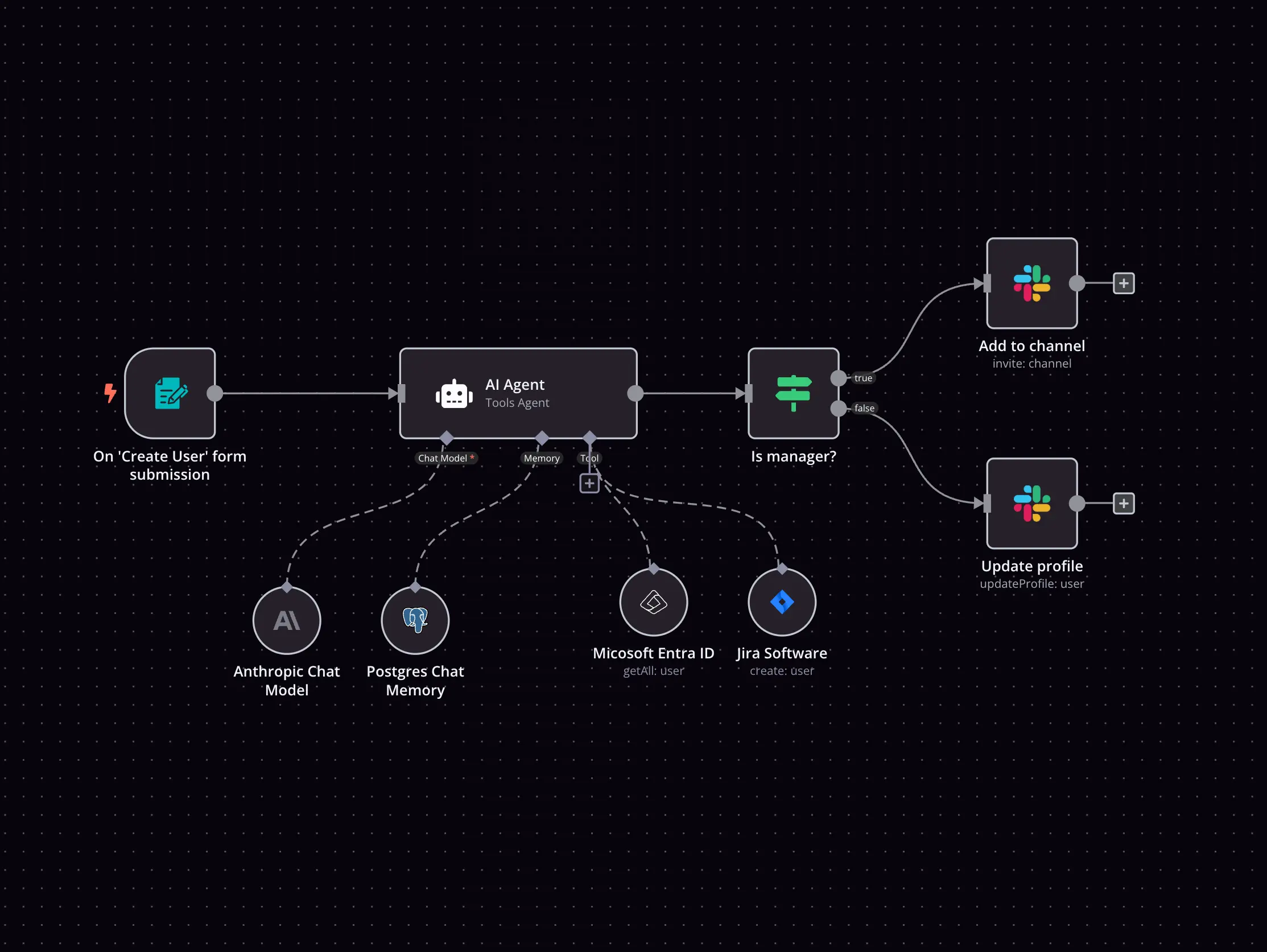Ably and Flotiq integration
Save yourself the work of writing custom integrations for Ably and Flotiq and use n8n instead. Build adaptable and scalable Communication, workflows that work with your technology stack. All within a building experience you will love.


How to connect Ably and Flotiq
Create a new workflow and add the first step
In n8n, click the "Add workflow" button in the Workflows tab to create a new workflow. Add the starting point – a trigger on when your workflow should run: an app event, a schedule, a webhook call, another workflow, an AI chat, or a manual trigger. Sometimes, the HTTP Request node might already serve as your starting point.
Build your own Ably and Flotiq integration
Create custom Ably and Flotiq workflows by choosing triggers and actions. Nodes come with global operations and settings, as well as app-specific parameters that can be configured. You can also use the HTTP Request node to query data from any app or service with a REST API.
Supported API Endpoints for Ably
Get channel
Creates a new Channel object if none for the channel exists, or returns the existing channel object.
Release channel
Releases a Channel object, deleting it and enabling it to be garbage collected.
List messages
Retrieve messages sent to a specified channel.
Publish message
Publish a message on a channel.
Publish message
Publish a message to a specified channel with optional parameters.
Retrieve presence status
Obtain the set of members currently present for a channel.
Retrieve presence state history
Obtain the history of presence messages for a channel.
Retrieve metadata
This returns ChannelDetails for the given channel, indicating global occupancy.
Enumerate all active channels
This enumerates all active channels in the application.
Release channel
Releases a Channel object, deleting it and enabling it to be garbage collected.
Publish message
Publish a single message on this channel based on a given event name and payload.
List messages
Retrieve a list of messages from a specific channel.
Publish message
Sends a message to a channel.
Get channel history
Gets a paginated set of historical messages for this channel.
Retrieve message history
Fetches the history of messages published on a channel.
Create token request
Creates and signs an Ably TokenRequest based on the specified tokenParams and authOptions.
Authenticate server
Authenticates a server with Ably and creates access tokens for clients.
Retrieve presence state
Obtains the current presence state of clients in a channel.
Retrieve application usage statistics
Fetches statistics for application usage over a specified period.
Register device
Register a device for receiving push notifications.
Update device registration
Update a device registration by replacing existing details.
List channels
Retrieve all channels with at least one subscribed device.
Publish notification
Send a push notification to a single device or set of devices.
Get details from a registered device
Obtain the details for a device registered for receiving push registrations.
List registered devices
Obtain the details for devices registered for receiving push registrations.
Unregister device
Unregisters a single device by its device ID, deleting all its subscriptions for receiving push notifications through channels.
Unregister devices
Unregisters devices, deleting all their subscriptions for receiving push notifications through channels.
Subscribe to channel
Subscribe a single device or all devices associated with a client ID to receive push notifications from messages sent to a channel.
Revoke tokens
Revoke tokens using the specified key name.
Publish message
Publish a single message on this channel based on a given event name and payload.
To set up Ably integration, add the HTTP Request node to your workflow canvas and authenticate it using a generic authentication method. The HTTP Request node makes custom API calls to Ably to query the data you need using the API endpoint URLs you provide.
See the example hereThese API endpoints were generated using n8n
n8n AI workflow transforms web scraping into an intelligent, AI-powered knowledge extraction system that uses vector embeddings to semantically analyze, chunk, store, and retrieve the most relevant API documentation from web pages. Remember to check the Ably official documentation to get a full list of all API endpoints and verify the scraped ones!
Supported API Endpoints for Flotiq
List content types
Retrieves a list of all content types available.
Create content type
Creates a new content type.
Update content type
Updates an existing content type.
Get single content type
Retrieves details of a specific content type.
Delete content type
Deletes a specific content type.
Create content type
Create a new content type definition.
Get content type
Retrieve a specific content type definition.
Update content type
Update an existing content type definition.
Delete content type
Delete an existing content type definition.
Create content type
Creates a new content type for the application.
Update content type
Updates an existing content type in the application.
List content types
Retrieves a list of all content types available in the application.
Get single content type
Retrieves a specific content type by its ID.
Delete content type
Deletes a specified content type from the application.
Create content type
Creates a new content type definition via API.
Update content type
Updates an existing content type definition.
List content types
Retrieves a list of content type definitions.
Get single content type
Retrieves a single content type definition by ID.
Delete content type
Deletes a specific content type definition by ID.
List content objects
Retrieves a list of all content objects.
Create content object
Creates a new content object.
Update content object
Updates an existing content object.
Get single content object
Retrieves details of a specific content object.
Delete content objects
Deletes a specific content object.
Create content object
Creates a new content object in the application.
Update content object
Updates an existing content object in the application.
List content objects
Retrieves a list of all content objects available in the application.
Get single content object
Retrieves a specific content object by its ID.
Delete content object
Deletes a specified content object from the application.
List deleted content objects
Retrieves a list of all deleted content objects.
Create content object
Creates a new content object based on a content type.
Update content object
Updates an existing content object.
List content objects
Retrieves a list of content objects.
Get single content object
Retrieves a single content object by ID.
Delete content object
Deletes a specific content object by ID.
Retrieve content object
Retrieve the schema of a specific Content Object by sending a GET request.
Delete content object
Delete a specific Content Object identified by its ID.
Retrieve GraphQL schema
Retrieve the GraphQL schema that describes your data.
Execute GraphQL queries
Execute GraphQL queries to retrieve specific data.
Get blogposts
Retrieve details of blogposts content type.
Create content type
Create a new Content Type Definition in the system.
Update content type
Updates the definition of the specified content type using a PUT request.
Update blogposts
Updates the schema definition for blog posts.
To set up Flotiq integration, add the HTTP Request node to your workflow canvas and authenticate it using a generic authentication method. The HTTP Request node makes custom API calls to Flotiq to query the data you need using the API endpoint URLs you provide.
See the example hereThese API endpoints were generated using n8n
n8n AI workflow transforms web scraping into an intelligent, AI-powered knowledge extraction system that uses vector embeddings to semantically analyze, chunk, store, and retrieve the most relevant API documentation from web pages. Remember to check the Flotiq official documentation to get a full list of all API endpoints and verify the scraped ones!
Ably and Flotiq integration details
FAQ
Can Ably connect with Flotiq?
Can I use Ably’s API with n8n?
Can I use Flotiq’s API with n8n?
Is n8n secure for integrating Ably and Flotiq?
How to get started with Ably and Flotiq integration in n8n.io?
Looking to integrate Ably and Flotiq in your company?
The world's most popular workflow automation platform for technical teams including
Why use n8n to integrate Ably with Flotiq
Build complex workflows, really fast


